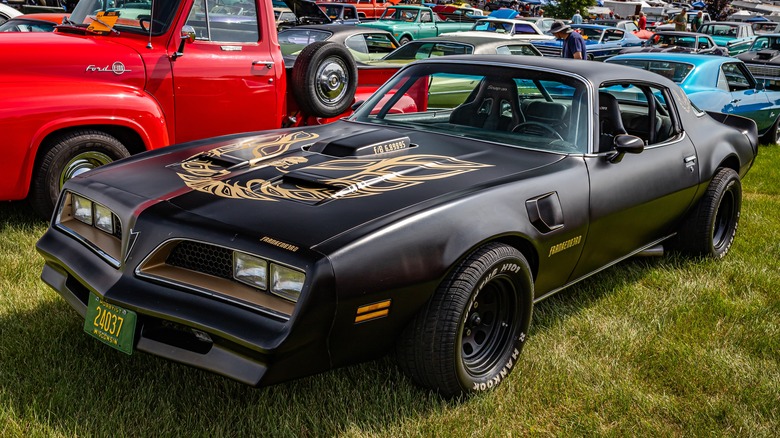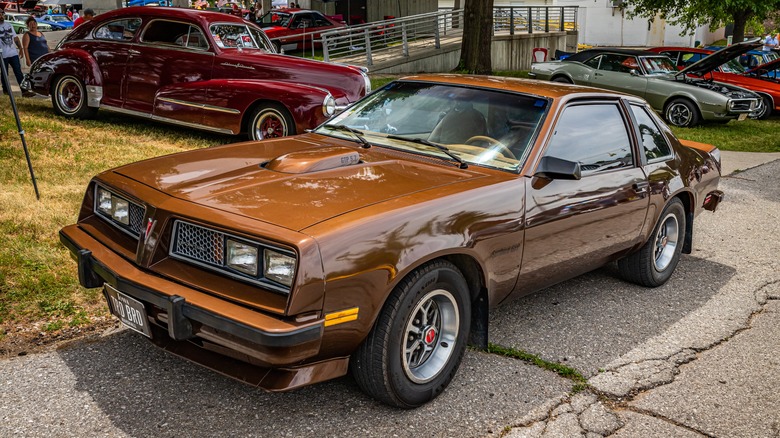Pontiac Firebird Vs Pontiac Sunbird: What's The Difference?
When you think about a muscle car, the Firebird will probably come to mind, especially if you're an enthusiast. It's a classic car that had the eponymous "sport's car" look, and the Firebird was a formidable competitor to legendary manufacturers like Mustang. It's frequently listed as one of the coolest looking Pontiac models ever made.
The Pontiac Sunbird, on the other hand, might not be a car many people bring up in conversation. Unlike the Firebird, it had several variations that suited drivers of all sorts and served more as a family or commuter car. While its earlier versions hold that classic look one expects from a muscle car, later iterations took a turn to fit what one would expect from a family sedan. But even the earlier models' engine options were never as powerful as anything you would find under the hood of a Firebird.
Which car is better is a matter of preference, but their lifespans indicate exactly how popular they were amongst drivers: The first Firebird hit the market nearly a decade prior to the first Sunbird and lasted eight years longer than it, too. Let's get into some of their key differences that set them apart.
The Pontiac Firebird was well-received then and now
The Pontiac Firebird is as classic as muscle cars get. It came about as a direct competitor to the Ford Mustang in 1967 and lasted until 2002. The engines that powered the Pontiac Firebird were beasts in every stretch of the word. Muscle car aficionados could choose between the Firebird's hardtop or convertible styles in its first generation, which housed engines that reached between 165 and 345 horsepower.
The Firebird's highly regarded second generation lasted from 1970 to 1981, with the first models produced in this generation sharing some similarities with Ferraris of the time. Under the hood, the 1970 Firebird had a 400-cubic-inch, 6.6-liter Ram Air IV engine that produced up to 370 horsepower.
However, the '70s were not kind to the industry because the oil crisis forced automobile manufacturers to cut down on emissions. These limitations made manufacturers build cars with smaller engines, and by 1980, no Firebird had a V8 engine larger than 5.0 liters. That required Pontiac to get a little creative with its third generation in 1982. So, it developed third-generation Firebird frames in a wind tunnel to create a more aerodynamic vehicle. Technology evolved over the years and Pontiac was able to swap out the old V8 for a more powerful General Motors LS V8 engine that pumped out between 305 to 330 horsepower. This helped maintain the Firebird's status as a muscle car up until production closed up shop for good in the 2000s.
The Pontiac Sunbird line offered a wide range of cars
The Pontiac Sunbird came about in 1976 as a budget option for Pontiac fans. While it evoked a similar sporty look as the Pontiac Firebird (even the name is reminiscent), Pontiac also produced two alternative designs to appeal to a larger base, including the three-door hatchback and a station wagon variant. When the car first landed on the showroom floor, it came with a 1.8-liter four-cylinder engine, but was later stocked with a 2.3-liter option. Unfortunately, these engines didn't produce much power, putting out only 78 horsepower.
However, the Sunbird got a more modern design in the '80s. Pontiac did away with the station wagon variant, and the start of the Sunbird's second generation in 1982 didn't even bear the Sunbird nameplate. Instead, Pontiac called it the J2000 because it used General Motor's J-frame as opposed to the H-frame. However, the Sunbird name returned again in 1984 before the Sunbird GT was released in 1985. This model housed a turbocharged 3.0-liter V6 engine under the hood. Two years later, the brand also introduced the Sunbird GT convertible.
The Sunbird entered its third and final generation in 1992, changing its aesthetic once again to fit the era and sporting a 3.1-liter V6 engine. Unfortunately, this car couldn't compete with the rise of imported car sales, and the brand discontinued it in 1994.

